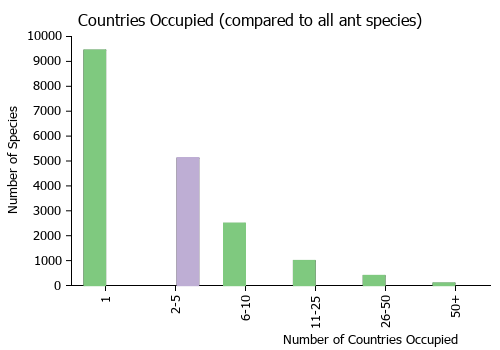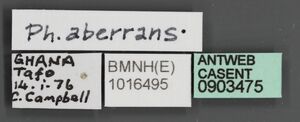Camponotus aberrans
| Camponotus aberrans | |
|---|---|

| |
| Scientific classification | |
| Kingdom: | Animalia |
| Phylum: | Arthropoda |
| Class: | Insecta |
| Order: | Hymenoptera |
| Family: | Formicidae |
| Subfamily: | Formicinae |
| Tribe: | Camponotini |
| Genus: | Camponotus |
| Subgenus: | Phasmomyrmex |
| Species: | C. aberrans |
| Binomial name | |
| Camponotus aberrans Mayr, 1895 | |
Identification
Distribution
Latitudinal Distribution Pattern
Latitudinal Range: 6.15° to -2.315°.
| North Temperate |
North Subtropical |
Tropical | South Subtropical |
South Temperate |
- Source: AntMaps
Distribution based on Regional Taxon Lists
Afrotropical Region: Central African Republic, Ghana (type locality), Nigeria, Uganda, Democratic Republic of Congo.
Distribution based on AntMaps
Distribution based on AntWeb specimens
Check data from AntWeb
Countries Occupied
| Number of countries occupied by this species based on AntWiki Regional Taxon Lists. In general, fewer countries occupied indicates a narrower range, while more countries indicates a more widespread species. |

|
Estimated Abundance
| Relative abundance based on number of AntMaps records per species (this species within the purple bar). Fewer records (to the left) indicates a less abundant/encountered species while more records (to the right) indicates more abundant/encountered species. |

|
Biology
Association with Other Organisms
 Explore: Show all Associate data or Search these data. See also a list of all data tables or learn how data is managed.
Explore: Show all Associate data or Search these data. See also a list of all data tables or learn how data is managed.
- This species is a host for the fungus Ophiocordyceps unilateralis (a parasitoid) (Quevillon, 2018) (encounter mode primary; direct transmission; transmission outside nest).
- This species is a host for the fungus Ophiocordyceps unilateralis (a pathogen) in Africa (Shrestha et al., 2017).
Castes
Images from AntWeb

| |
| Worker. Specimen code casent0250082. Photographer Peter Hawkes, uploaded by Curator Peter Hawkes AFRC. | Owned by AFRC, Pretoria, South Africa. |
     
| |
| Male (alate). Specimen code casent0903475. Photographer Will Ericson, uploaded by California Academy of Sciences. | Owned by NHMUK, London, UK. |
   
| |
| Worker. Specimen code casent0905182. Photographer Will Ericson, uploaded by California Academy of Sciences. | Owned by MSNG, Genoa, Italy. |
Nomenclature
The following information is derived from Barry Bolton's Online Catalogue of the Ants of the World.
- aberrans. Camponotus aberrans Mayr, 1895: 152 (q.) GHANA.
- Santschi, 1915c: 264 (w.).
- Combination in C. (Myrmorhachis): Forel, 1914a: 274; Wheeler, W.M. 1922a: 707;
- combination in C. (Myrmacantha): Emery, 1920b: 246;
- combination in Phasmomyrmex (Myrmacantha): Emery, 1925b: 58;
- combination in Camponotus (Phasmomyrmex): Ward, et al. 2016: 349.
- Status as species: Emery, 1896d: 376 (in list); Santschi, 1910c: 393; Santschi, 1915c: 264; Emery, 1920c: 30; Wheeler, W.M. 1922a: 987; Emery, 1925b: 58; Bolton, 1995b: 316.
Description
References
- Chanda, A. 2017. A study on ants (Hymenoptera: Formicidae) of Medinipur, West Bengal, India. International Journal of Entomological Research 2(5): 1-4.
- Emery, C. 1920b. Le genre Camponotus Mayr. Nouvel essai de la subdivision en sous-genres. Rev. Zool. Afr. (Bruss.) 8: 229-260 (page 246, Combination in C. (Myrmacantha))
- Emery, C. 1925d. Hymenoptera. Fam. Formicidae. Subfam. Formicinae. Genera Insectorum 183: 1-302 (page 58, Combination in Phasmomyrmex (Myrmacantha))
- Forel, A. 1914a. Le genre Camponotus Mayr et les genres voisins. Rev. Suisse Zool. 22: 257-276 (page 274, Combination in C. (Myrmorhachis))
- Mayr, G. 1895. Afrikanische Formiciden. Ann. K-K. Naturhist. Mus. Wien 10: 124-154 (page 152, queen described)
- Santschi, F. 1915c. Nouvelles fourmis d'Afrique. Ann. Soc. Entomol. Fr. 84: 244-282 (page 264, worker described)
- Shrestha B, Tanaka E, Hyun MW, Han JG, Kim CS, Jo JW, Han SK, Oh J, Sung JM, Sung GH. 2017. Mycosphere Essay 19. Cordyceps species parasitizing hymenopteran and hemipteran insects. Mycosphere 8(9): 1424–1442 (DOI 10.5943/mycosphere/8/9/8).
- Ward, P.S., Blaimer, B.B., Fisher, B.L. 2016. A revised phylogenetic classification of the ant subfamily Formicinae (Hymenoptera: Formicidae), with resurrection of the genera Colobopsis and Dinomyrmex. Zootaxa 4072 (3): 343–357 (doi:10.11646/zootaxa.4072.3.4).
- Wheeler, W. M. 1922i. Ants of the American Museum Congo expedition. A contribution to the myrmecology of Africa. VII. Keys to the genera and subgenera of ants. Bull. Am. Mus. Nat. Hist. 45: 631-710 (page 707, Combination in C. (Myrmorhachis))
References based on Global Ant Biodiversity Informatics
- Emery C. 1920. Studi sui Camponotus. Bullettino della Società Entomologica Italiana 52: 3-48.
- Majer J. D. 1976. The ant mosaic in Ghana cocoa farms: further structural considerations. Journal of Applied Ecology 13: 145-155.
- Santschi F. 1910. Formicides nouveaux ou peu connus du Congo français. Annales de la Société Entomologique de France 78: 349-400.
- Santschi F. 1915. Nouvelles fourmis d'Afrique. Annales de la Société Entomologique de France 84: 244-282.
- Tadu Z., C. Djieto-Lordon, R. Babin, Yede, E. B. Messop-Youbi, and A. Fomena. 2013. Influence of insecticide treatment on ant diversity in tropical agroforestry system: some aspect of the recolonization process. International Journal of Biodiversity and Conservation 5(12): 832-844.
- Taylor B. 1978. Ants of the Nigerian Forest Zone (Hymenoptera: Formicidae). II. Formicinae, Dolichoderinae. Cocoa Research Institute of Nigeria Research Bulletin 5: 1-57.
- Wheeler W. M. 1922. Ants of the American Museum Congo expedition. A contribution to the myrmecology of Africa. VIII. A synonymic list of the ants of the Ethiopian region. Bulletin of the American Museum of Natural History 45: 711-1004

